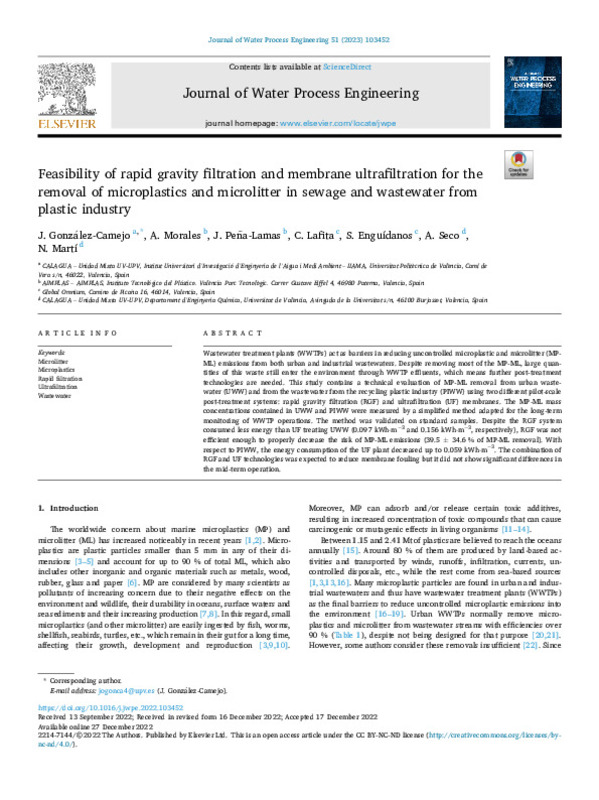JavaScript is disabled for your browser. Some features of this site may not work without it.
Buscar en RiuNet
Listar
Mi cuenta
Estadísticas
Ayuda RiuNet
Admin. UPV
Feasibility of rapid gravity filtration and membrane ultrafiltration for the removal of microplastics and microlitter in sewage and wastewater from plastic industry
Mostrar el registro sencillo del ítem
Ficheros en el ítem
| dc.contributor.author | González-Camejo, J.
|
es_ES |
| dc.contributor.author | Morales, A.
|
es_ES |
| dc.contributor.author | Peña-Lamas, J.
|
es_ES |
| dc.contributor.author | Lafita, C.
|
es_ES |
| dc.contributor.author | Enguídanos, S.
|
es_ES |
| dc.contributor.author | Seco, A.
|
es_ES |
| dc.contributor.author | Martí, N.
|
es_ES |
| dc.date.accessioned | 2024-02-29T19:02:55Z | |
| dc.date.available | 2024-02-29T19:02:55Z | |
| dc.date.issued | 2023-02 | es_ES |
| dc.identifier.uri | http://hdl.handle.net/10251/202852 | |
| dc.description.abstract | [EN] Wastewater treatment plants (WWTPs) act as barriers in reducing uncontrolled microplastic and microlitter (MP-ML) emissions from both urban and industrial wastewaters. Despite removing most of the MP-ML, large quantities of this waste still enter the environment through WWTP effluents, which means further post-treatment technologies are needed. This study contains a technical evaluation of MP-ML removal from urban wastewater (UWW) and from the wastewater from the recycling plastic industry (PIWW) using two different pilot-scale post-treatment systems: rapid gravity filtration (RGF) and ultrafiltration (UF) membranes. The MP-ML mass concentrations contained in UWW and PIWW were measured by a simplified method adapted for the long-term monitoring of WWTP operations. The method was validated on standard samples. Despite the RGF system consumed less energy than UF treating UWW (0.097 kWh·m-3 and 0.156 kWh·m-3, respectively), RGF was not efficient enough to properly decrease the risk of MP-ML emissions (39.5 ± 34.6% of MP-ML removal). With respect to PIWW, the energy consumption of the UF plant decreased up to 0.059 kWh·m-3. The combination of RGF and UF technologies was expected to reduce membrane fouling but it did not show significant differences in the mid-term operation. | es_ES |
| dc.description.sponsorship | This research work was supported by the Agència Valenciana de la Innovació (AVI) of the Generalitat Valenciana (Spain) through the Project MICROPLAST (INEST00/19/058), which is gratefully acknowledged. It was also supported by the Entitat Pública de Sanejament d'Aigües Residuals de la Comunitat Valenciana (EPSAR) and the Camp de Turia Mancommunity. First author J. Gonzalez-Camejo is also grateful to the Spanish Ministry of Universities and the NextGenerationEU for their support via a Margarita Salas Grant. | es_ES |
| dc.language | Inglés | es_ES |
| dc.publisher | Elsevier | es_ES |
| dc.relation.ispartof | Journal of Water Process Engineering | es_ES |
| dc.rights | Reconocimiento - No comercial - Sin obra derivada (by-nc-nd) | es_ES |
| dc.subject | Microlitter | es_ES |
| dc.subject | Microplastics | es_ES |
| dc.subject | Rapid filtration | es_ES |
| dc.subject | Ultrafiltration | es_ES |
| dc.subject | Wastewater | es_ES |
| dc.title | Feasibility of rapid gravity filtration and membrane ultrafiltration for the removal of microplastics and microlitter in sewage and wastewater from plastic industry | es_ES |
| dc.type | Artículo | es_ES |
| dc.identifier.doi | 10.1016/j.jwpe.2022.103452 | es_ES |
| dc.relation.projectID | info:eu-repo/grantAgreement/Agència Valenciana de la Innovació//INNEST00%2F19%2F058//MICROPLAST - Caracterización de aguas y lodos residuales urbanos e industriales y evaluación de la tecnología adecuada para la recuperación de microplásticos presentes en los mismos / | es_ES |
| dc.rights.accessRights | Abierto | es_ES |
| dc.description.bibliographicCitation | González-Camejo, J.; Morales, A.; Peña-Lamas, J.; Lafita, C.; Enguídanos, S.; Seco, A.; Martí, N. (2023). Feasibility of rapid gravity filtration and membrane ultrafiltration for the removal of microplastics and microlitter in sewage and wastewater from plastic industry. Journal of Water Process Engineering. 51. https://doi.org/10.1016/j.jwpe.2022.103452 | es_ES |
| dc.description.accrualMethod | S | es_ES |
| dc.relation.publisherversion | https://doi.org/10.1016/j.jwpe.2022.103452 | es_ES |
| dc.type.version | info:eu-repo/semantics/publishedVersion | es_ES |
| dc.description.volume | 51 | es_ES |
| dc.identifier.eissn | 2214-7144 | es_ES |
| dc.relation.pasarela | S\501471 | es_ES |
| dc.contributor.funder | European Commission | es_ES |
| dc.contributor.funder | Agència Valenciana de la Innovació | es_ES |
| dc.contributor.funder | Universitat Politècnica de València | es_ES |
| dc.contributor.funder | Entitat Pública de Sanejament d'Aigües Residuals de la Comunitat Valenciana | es_ES |
| dc.subject.ods | 06.- Garantizar la disponibilidad y la gestión sostenible del agua y el saneamiento para todos | es_ES |








